Preliminary report by Clint Bancroft:
We did not make any organized observations because we were both overwhelmed to find the trees bearing seeds. Approximately 82 seeds were gathered by us.
At least three of the trees had basal sprouts and we took cuttings of those, including some apicals, and took branch cuttings from the trees without basal sprouts.
Even having watched the video about the trees prior to going to NC I am not able to provide you with an update on the grove, but Jack Johnston can give you an update. He was there previously — and he has much quicker observation skills than I ever had.
• April 2019: Proof that cutting of basal leader tip yields tree-form Torreya
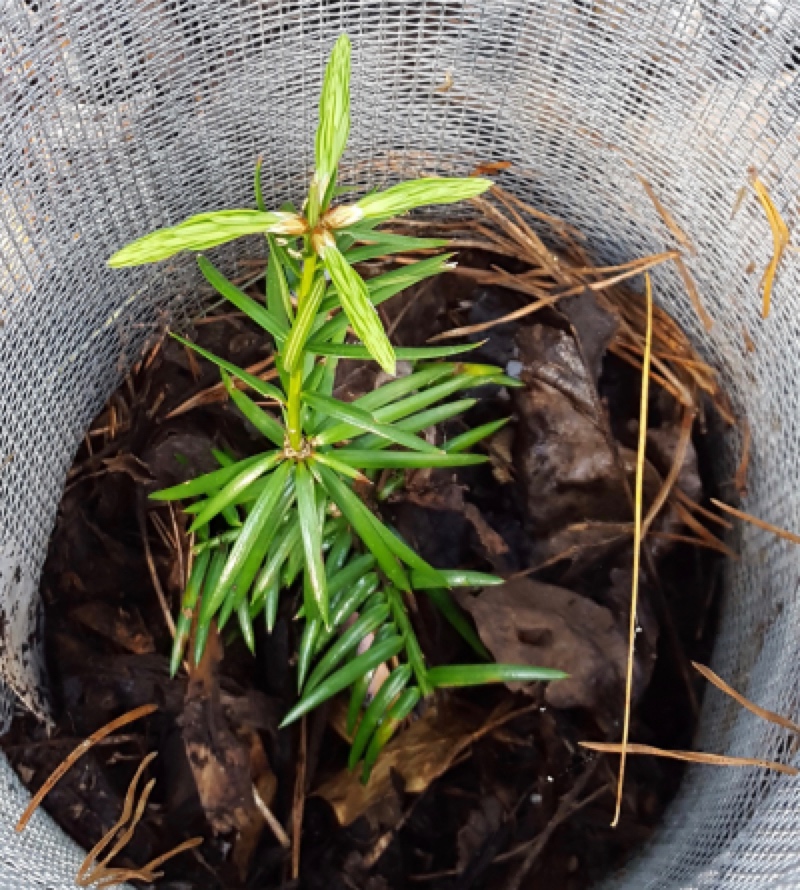 |
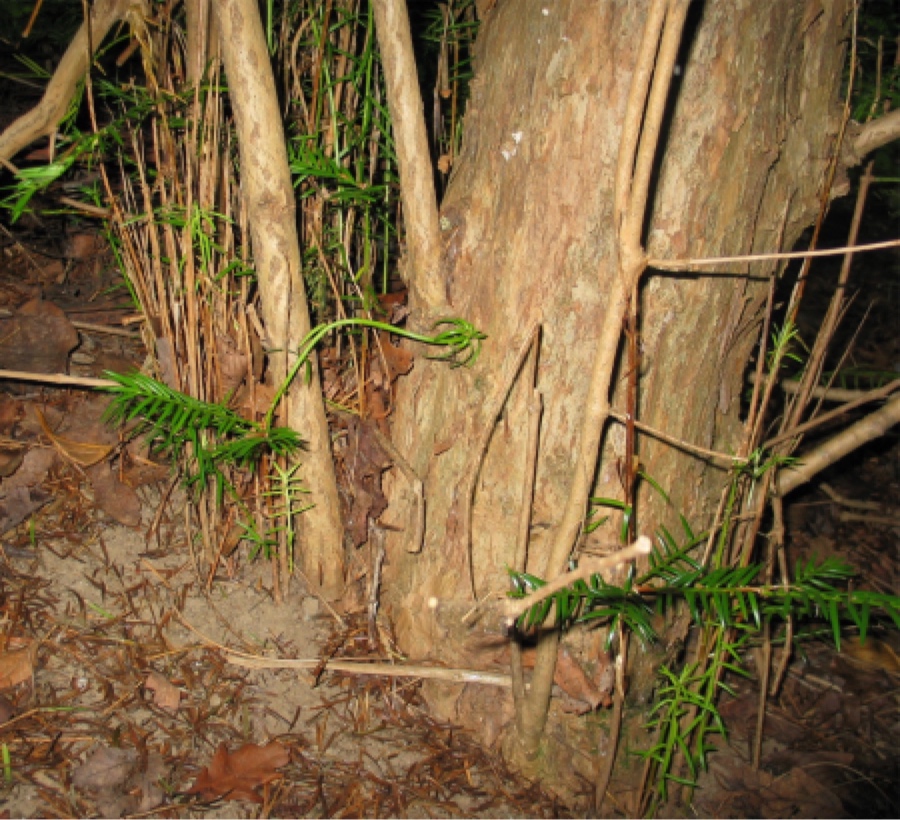 |
|
April 24 email from Clint Bancroft (Torreya planter in Ocoee watershed of Tennessee) to Connie Barlow:
"Look at the new growth on this cutting from Highlands, NC! The cutting is the apical tip from a basal of one of the mature trees."
Photo left, by Clint Bancroft, is April 2019 of a rooted cutting (collected October 2017) that displays superb vertical growth. Photo right is by Connie Barlow 2006, during a Torreya Guardians site visit to the near-century old Highlands NC Torreya grove. Notice the prolific basal sprouting, of various ages.
|
LEARNING: The original cuttings of wild specimens in the Florida panhandle were collected three decades ago from branches that necessarily assume shrubby growth forms. Wild stock was so weak that cutting of basal terminals would not have been appropriate. However, when collecting vegetative growth from healthy horticultural plantings in northward states, we now know that apical growth of basals are essential for ultimately producing tree forms.
• May 2019: First of October 2017 Highlands seed harvest germinates
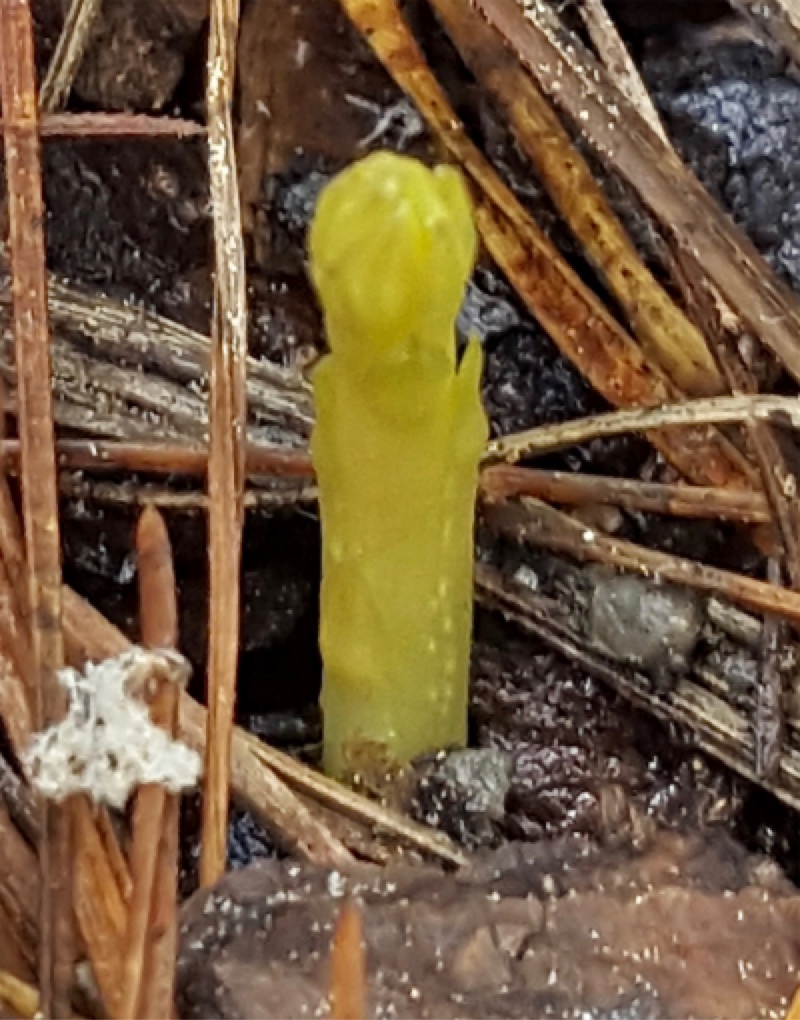 |
|
May 6 email from Clint Bancroft (Torreya planter in Ocoee watershed of Tennessee) to Connie Barlow:
"Highlands germination! It is being kept in extreme protective custody."
Note by Connie: See the October 2017 entry above about the visit to Harbison House grove mid-October 2017 with Jack Johnston, which is when the seeds were collected.
Clint has his seed beds and rooted branchlets outdoors in with a deer-proof exclosure. But a woodchuck apparently had a feast there in the past, so now he puts wire mesh over the tops of the exclosures too.
|
• July 2019 / Clint Bancroft / Precious apical cutting of a Highlands NC basal recovers from herbivory
CLINT BANCROFT writes:
Regarding my accidental experiment in which a rooted apical cutting had put up a new 6 inch vertical and then all but a few inches of the whole pant was eaten. In just 2 months or so, the eaten-down stump is putting up what appears to be a new vertical leader.
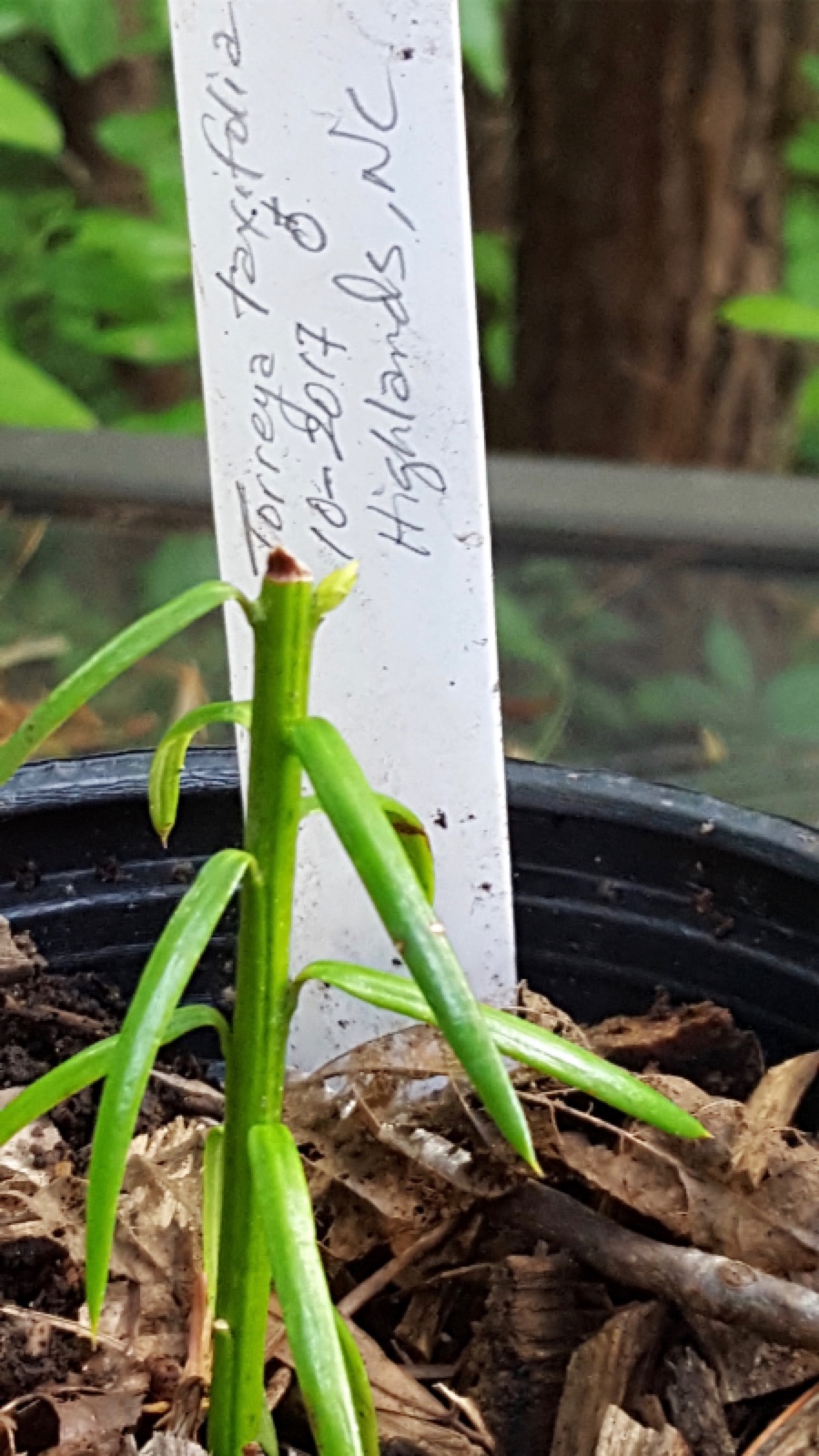 |
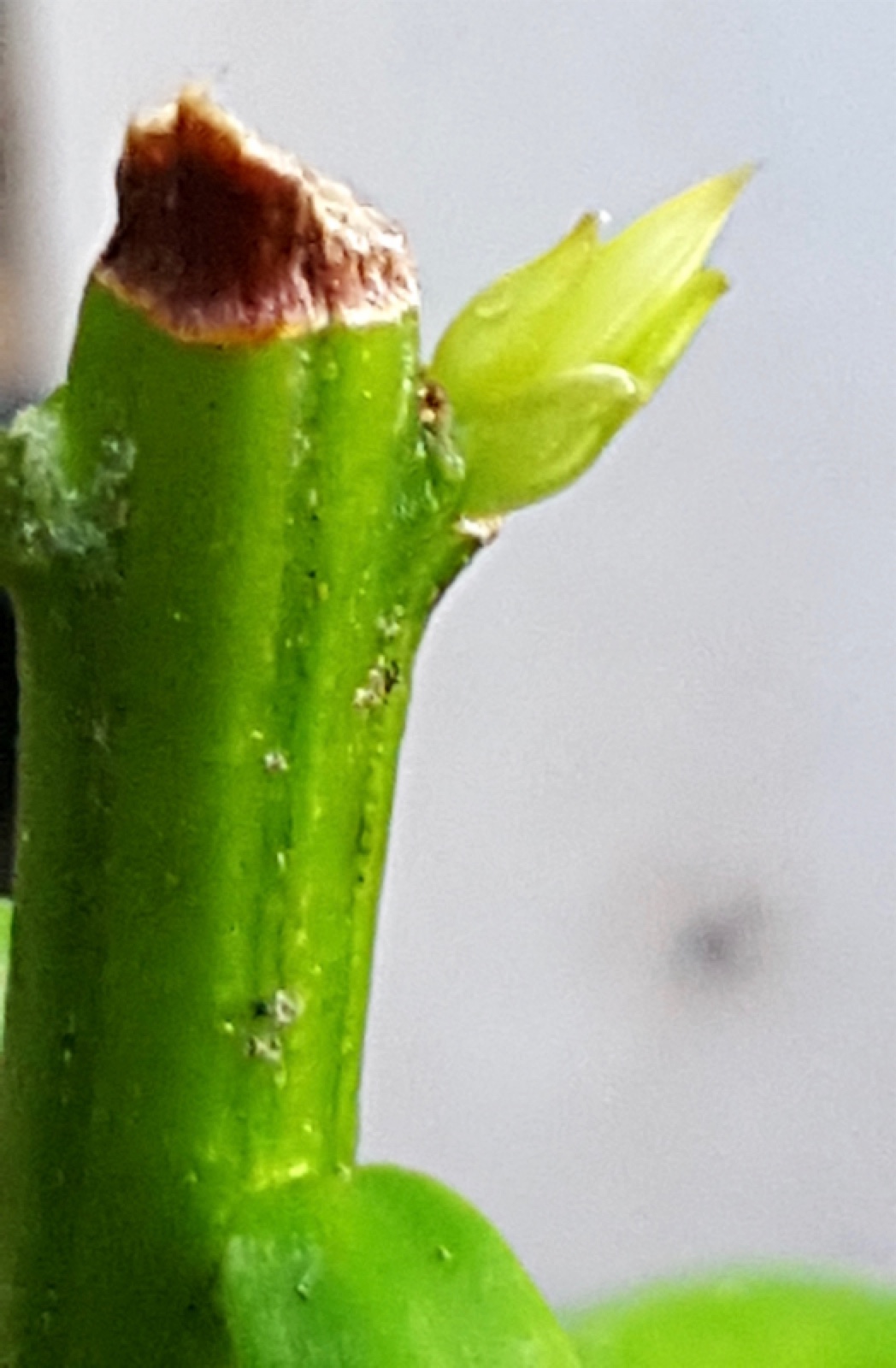 |
|
Note by Connie Barlow: I am reading about Coast Redwood basal growth and propagation now. Genus Sequoia and Torreya, ancient members of Cupressaceae Family, have probably survived this long thanks to their ability to produce new stems from basal growth if the original stem fails (or is logged). The term for what we see in photo left is an axillary bud doing what it evolved to do — produce a new vertical leader. Apparently all single leaves produced on the vertical main stem each carry on their upper side a suppressed axillary bud. For redwoods, each of those buds can become either a vertical leader or a root, depending on whether it senses air or soil when hormones direct it to wake up. Apparently Torreya can do the same, so we can actually obtain more than one vertical clone from each basal sprout we cut from.
|
• October 2019: Two Highlands seeds and 20 apical cuttings from basals collected
CLINT BANCROFT writes:
Jack and I went to Highlands on Monday and collected the ENTIRE seed crop (a total of 2 seeds) for 2019. They look smallish and were still green. Jack thinks they will be fine if we leave them to ripen a bit before planting them.
The Highlands Torreyas all look to be healthy. I took about 20 apical cuttings [of the prolific basal sprouts]. Jack took a bunch of laterals. I am about through with laterals, since they have been failing to put out new growth in spite of having rooted some years ago. So maybe this latest group will do well. Hated to appear greedy, but the property is for sale and I never know if this will be our last access to this grove.
Update on previous seed/cuttings collecting at Highlands: I have one seedling that grew from a Highlands seed and several Highlands cuttings (apical) that are coming along well.
• March 2020 / Clint Bancroft / 2017 apical cutting of Highlands basal has developed superb roots
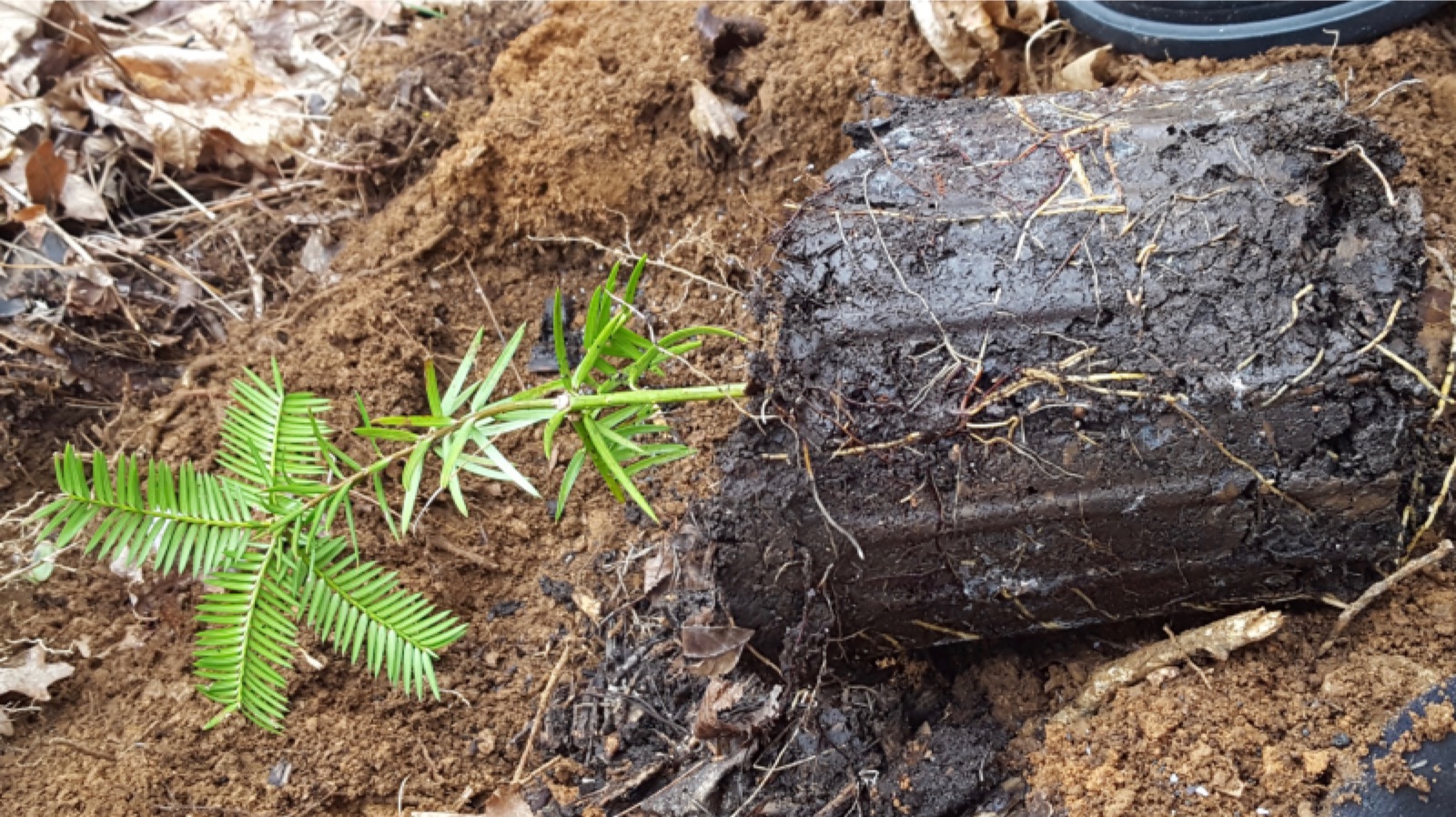
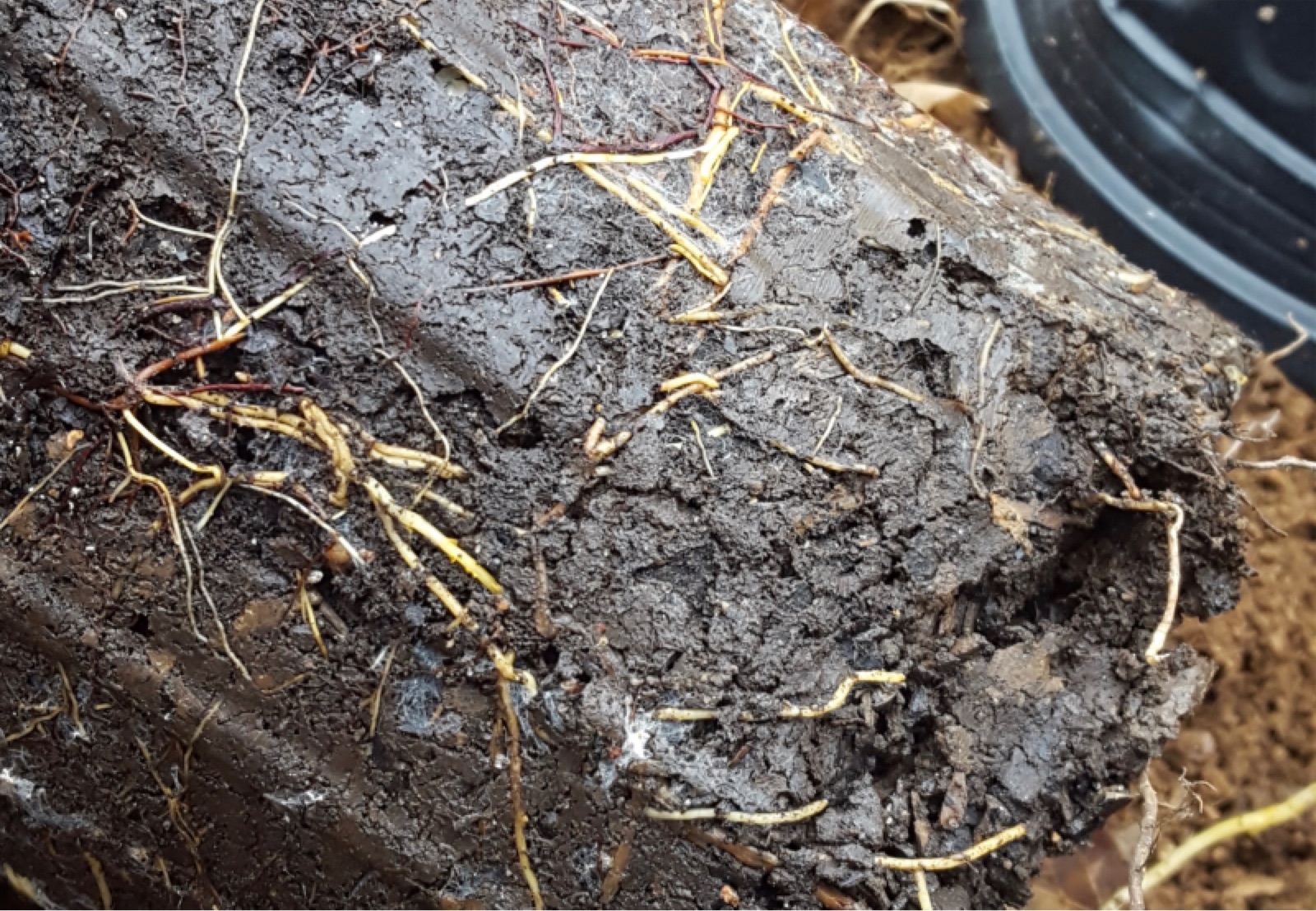 |
|
CLINT BANCROFT writes:
Here is the apical cutting [just removed from its pot] that put on four laterals last year. [Scroll up to the April 2019 entry to see the photo of this same rooted cutting with its four fresh little laterals.]
Look at the roots she developed! It currently has a central bud ready to go this spring, but no [second tier of] lateral buds at this time.
Although I was very pleasantly surprised by the root development, I don't know if this is typical or exceptional root formation since this is the first rooted cutting I have removed from its rooting pot.
This is the first cutting-grown Torreya to go into the Bowl. [The "Bowl" is a section of Clint's forest into which diverse genetics of Torreya are being planted with the goal of ultimately producing genetically diverse seeds. Clint's Torreya page has a "March 2019 Site Visit" illustrated section that documents his establishment of this "Torreya Bowl."]
I will be certain to label it as CUTTING GROWN so that we can learn if a cutting-grown apical will eventually form basal sprouts.
______
VISIT CLINT'S TORREYA WEBPAGE AND THE PROPAGATE WEBPAGE FOR MORE DETAIL:
• Ocoee Watershed, TN (Clint Bancroft)
• Propagate Torreya
|
• JULY 2021 report by Paul Camire of Capac Michigan: "The Torreya in full sun are beginning their second wave of growth this year. Those on the woods look like buds may be getting ready to swell for a second spurt. I lost a few that were in pots, that I got when I visited Clint last fall. Maybe a display of cold hardiness in the rest? Who knows. One of my Highlands Torreya seeds sprouted that I received from Clint 2 years ago. He sent me six and hopefully I will have more grow. It sprouted a week and a half ago."
• OCTOBER 2021 report by Paul: "I ended up with three germinated Highlands seeds that I received from Clint's 2019 expedition there."
• October 2021 / Clint Bancroft / 2021 harvest yields 64 seeds; new owners cut adjacent forest
For the second year in a row Clint Bancroft led the effort to harvest seeds at the grove, with permission of the owners. This year the owners are new, but Clint reports that they are aware of the importance of the torreya grove. In the photos above, you can see that the forest removal in preparation for landscaping went up to the one side of the grove. CLINT says:
"The new owners are aware of the trees and their rarity. They are doing a lot of landscaping work and have cleared a significant space on the north and east of the existing grove. So the Torreya grove is now exposed to much more light. It will be interesting to see if seed production will be greater next year if we are allowed to return next year. I am sending pictures of the grove as it appears now. All of the trees appear in very good health."
Because the trees are so tall, the man is opening the extensions of a seed collecting tool for reaching seeds high in the canopy. Clint reports that "all of the seeds were on the east-facing side of the single seed-producing tree." He reported that every visible seed was collected from the tree: 64 seeds. That is about the same number as the team collected the previous years. (All photos by Clint Bancroft.)
PHOTOS ABOVE AND BELOW: Clint also captured photos of 3 large saplings that we have also documented during previous visits. The grove itself and all its saplings are sheltered beneath a deciduous canopy. ABOVE LEFT: Notice the fallen deciduous leaves, with the paved road slightly visible in the distance. ABOVE RIGHT: A close-up of the same sapling's top shows very healthy growth, beneath a canopy of tuliptree (Liriodendron). Other canopy species onsite include basswood, [ADD SPECIES ] ____________.
 |
 |
|
PHOTOS LEFT:
Two additional saplings, which are offspring of the mature grove.
Distance from the grove of the tree at far left is estimated at ___________.
The smaller sapling is about ____________ from its parent grove.
The team reported (but did not photograph) two very young seedlings (possibly second year) "well within the drip-line of the grove." So these seedlings will also remain, despite the landscaping changes that follow.
|
PHOTO BELOW: A close-up view of the grove's lower branches. Despite the intense deciduous shade, they are lush. Genus Torreya is a subcanopy tree, capable of growing beneath a deciduous canopy here in the eastern USA, and (in California) remaining healthy but slow-growing beneath an evergreen conifer canopy (Coast Redwood and Douglas-fir) in the Coast Range and evergreen broad-leaf canopy (Bay Laurel and Live Oak) in the Sierras. Seed production and strong vertical growth generally happen only when the forces of nature (or human road-building or logging) open a canopy slot for sunlight to penetrate.
Because this side of the grove is now suddenly open to sunlight, the current set of evergreen leaves may bronze. But the experience of Torreya Guardians indicates that bronzing soon repairs into leaves that are supplied with adequate UV protection and become green again — with new-grown leaves becoming larger and with a pattern that is less flat. The good news is that we can also expect a bounty of seeds in future years produced on the now-sunny side of the grove.

__________
• October 2022 / Clint Bancroft / 2022 harvest yields 40 seeds; no more clearing had been done
"There had been no further clearing around the Torreyas beyond what they had just done last year. The seeds all were on one tree, all on one side, and most were pretty close to the ground, close enough to hand pick.
Narrative of the "Grounds" Section
of the document certifying this site on the
NATIONAL HISTORIC REGISTER
The woodland character of the Harbison House grounds, with natural plant, leaf, and pine needle cover and no mown grass, dates to ca. 1921 when Mr. Harbison and his family occupied their newly-built house. According to local tradition, the Harbison House occupies the site of the former Martha Teague house. Given the agreeableness of the site, the protection of Satulah Mountain at its back, and the splendid expansive views from the house's two-tier south porch over the landscape of three states, the siting of the Harbison House has few equals in Highlands. While the location of the house might be pre-ordained, Mr. Harbison's decision to maintain the woodland character of his grounds was conscious and in sympathy with his long career as a botanist.
The historic grounds of the Harbison House reflect three periods. The first, dating from ca. 1921 until Mr. Harbison's death in 1936, is associated with his work as a botanist. Some significant portion of the open aged grove of hemlock, white pine, and oak trees that forms the towering canopy of the property date to his years here. The group of six Torreya taxifolia that stands to the east/southeast of the house is known to have been planted by Mr. Harbison. These mid-height trees are native to Florida and are listed on the Federal Endangered Species List. The trees were probably gathered by Mr. Harbison on one of his collecting expeditions for the Arnold Arboretum. This group and some dozen or so on the Biltmore Estate in the Azalea Garden, which probably all (save perhaps one) date to a late 1930s planting by Chauncey Beadle, are the only examples in Western North Carolina. They continue to attract visits by professional botanists at Clemson University and others in the field on a periodic basis. The informal, natural understory of native dogwoods, mountain laurel and rhododendrons growing alone and in clusters throughout the acreage, and the introduced azaleas date in some part to the 1920s and 1930s and, as is likely, some are the natural offspring of plants here in Mr. Harbison's day. (full text here)
Here is a portion of the Thomas Grant Harbison biography section of the National Historic Register document online:
 |
|
In 1897 Thomas Grant Harbison began his professional career as a botanist that continued through the remainder of his life. From 1897 to 1903 he was employed as a plant collector and botanist for the Biltmore Herbarium, developed as a part of the large horticultural and agricultural operations carried out for George Washington Vanderbilt. From 1905 to 1926 Mr. Harbison traveled throughout the American South and Southwest as a plant collector for the Arnold Arboretum under the direction of Dr. Charles Sprague Sargent (1841-1927). His work was critical to Dr. Sargent's production of the second edition of his landmark Manual of the Trees of North America published in 1922. The third and final stage in Mr. Harbison's career as a botanist followed on the death of his long-time friend and colleague, William Willard Ashe, in 1932. Mr. Harbison cooperated with Mrs. Ashe and Dr. William Chambers Coker, founder of the University Herbarium at the University of North Carolina and a professor of botany, to secure the important Ashe Herbarium for the University Herbarium. In 1934 Mr. Harbison was appointed curator of the University Herbarium and died in that post on 12 January 1936. |
The Harbison House remained a residence of his family until ca. 1985, and in the ownership of the family until January 2000, when it was acquired and restored by the present owners. Mr. Harbison's residence is one carrier of his memory, and his important roles as a botanist and educator are honored in other ways.
Today, eight plants carry Mr. Harbison's name, including Crataegus harbisonii, which was named for him by Chauncey Beadle and published in Dr. Sargent's first, 1905 edition of his Manual of the Trees of North America. In fall 2003 a North Carolina Highway Historical Marker was erected in Highlands honoring his work as a botanist and educator. . . . Mr. Harbison came to the estate in 1897 as a plant collector and, as such, traveled through much of the United States.
"The spring and early summer of 1898 he spent in studying and making collections of the plants in the eastern part of our state; the late summer and fall he spent in similar work in the Rockies, the Cascades, and the western Coast Ranges. He continued in such work, studying and collecting plants, mostly in our southern states, until the discontinuance of the herbarium at Biltmore in 1903" (Journal of the Elisha Mitchell Society, 52 /142).
During this period Mr. Harbison contributed two articles to the Biltmore Botanical Studies, another casualty of retrenchment that appeared only in 1901-1902 as two numbers of volume one. For all or a portion of his employment at Biltmore, Mr. Harbison had Frank E. Boynton, another Highlands resident, as a colleague in his work.
. . . The matter of when Thomas Grant Harbison first met Charles Sprague Sargent, the founding director of the Arnold Arboretum at Jamaica Plain, Massachusetts, and the foremost authority on trees in late-nineteenth and early twentieth-century America, remains to be confirmed. However, he would have known of Dr. Sargent, his study of trees, and the development of the Arnold Arboretum, by the early 1880s, before he came to Highlands in spring 1886 and then returned that summer. In Highlands he would have learned of Dr. Sargent's first (known) visit to the Highlands area, and possibly the resort itself, in September 1885 from Frank E. Boynton, who served as a guide for the botanist. On that visit Mr. Boynton and Dr. Sargent rediscovered Shortia galacifolia growing "on the southern slopes of the Blue Ridge near the head waters of the Keowee river," along the North Carolina/South Carolina border. Whether the find was made in today's Transylvania County, North Carolina, or Oconee County, South Carolina, is unclear. Mr. Boynton found the famed "Oconee Bells" in fall 1886 "growing in great abundance in another cove on the same slope . . . called Bear Camp" in the region where the plant was
discovered by Andre Michaux in 1787 (The Highlander, 12 November 1886).
Frank Boynton, a Highlands resident, was one link between the two men, Messrs. Harbison and Sargent. The other was Chauncey Delos Beadle, his supervisor in the work for the Biltmore Herbarium. Mr. Beadle was a professional colleague of Dr. Sargent's, and both were greatly interested in the species Crataegus and both had substantial plantings of hawthorns at Biltmore and the Arnold Arboretum, respectively, dating from about the turn of the twentieth century (Sutton, 288-89). In 1905, when Dr. Sargent's Manual of the Trees of North America (Exclusive of Mexico) was published, he included a hawthorn named by Mr. Beadle for Mr. Harbison, Crataegus Harbisoni (sic). Apparently this was the first of at least eight known species named for Mr. Harbison.
Thomas Grant Harbison devoted one of the eight pages of his "Auto-Biographical Sketch" to his work for Dr. Sargent and the Arnold Arboretum.
"This arboretum aims to grow every species of tree and shrub in the world that will endure that climate. This is a formidable undertaking and will take time and much money. Mr. Vanderbilt volunteered to donate the service of his collectors in the South. In this way I became well acquainted with Sargent. When we had finished our work for Mr. Vanderbilt and I was about to take up educational work again, Sargent took me to task for thinking of abandoning a work for which there was far too few trained men for a work that had plenty of applicants. He persuaded me to continue botanical work and devote my time to trees and shrubs. I did my first work for him in 1905 and the last in 1926. My task was to find all unknown and little known trees and thrubs (sic) and also to trace the distribution of all the known ones. I was to get seeds and cuttings of everything in the southern states not already growing in the arboretum, but my chief work was to study critically every species, keeping in mind the revision of his manual of trees of North America. I visited all parts of the South, and made many corrections and additions for his Manual. Sargent is supposed to be the highest authority on trees in the world. My quarter of a century closely connected with him, including trips with him in the woods I should think, in a measure at least, make up for a term I missed at the University under some professor who learned mostly from books."
. . . He was a pioneer in securing national forests for the western part of North Carolina, turned over much of his own land to the government at a very low rate and by his advocacy and example persuaded his neighbors to do the same. . . Though a lover of timber trees, he also knew and loved all humbler plants too and fully realized their cultural value. He was an early advocate for a great National park in the North Carolina mountains and was an early contributor and played a part in securing the cooperation of the mountain people in what has resulted in the Smoky Mountain National Park.
Note: The 8 plants named after Thomas Grant Harbison are: Crataegus harbisonii, Salix harbisonni, Viburnum cassinoides var. harbisonii, Quercus harbisonnii, Aesculus harbisonni, Astragalus harbisonii, Vaccinum neglectum var. harbisonnii, and Verbena harbisonni.
A Franklinia Heritage Tree is in the front of the Peggy Crosby Center at 348 South Fifth Street in Highlands.
Could Florida Torreya Take the Place of Eastern Hemlock? This is a proposal posted as a photo-rich essay in April 2015 by Torreya Guardian Connie Barlow. It features the now-wild quality of the 90-year-old Highlands Torreya Grove as a prime site to study for similarities to the physiology and ecological functions of Torreya taxifolia
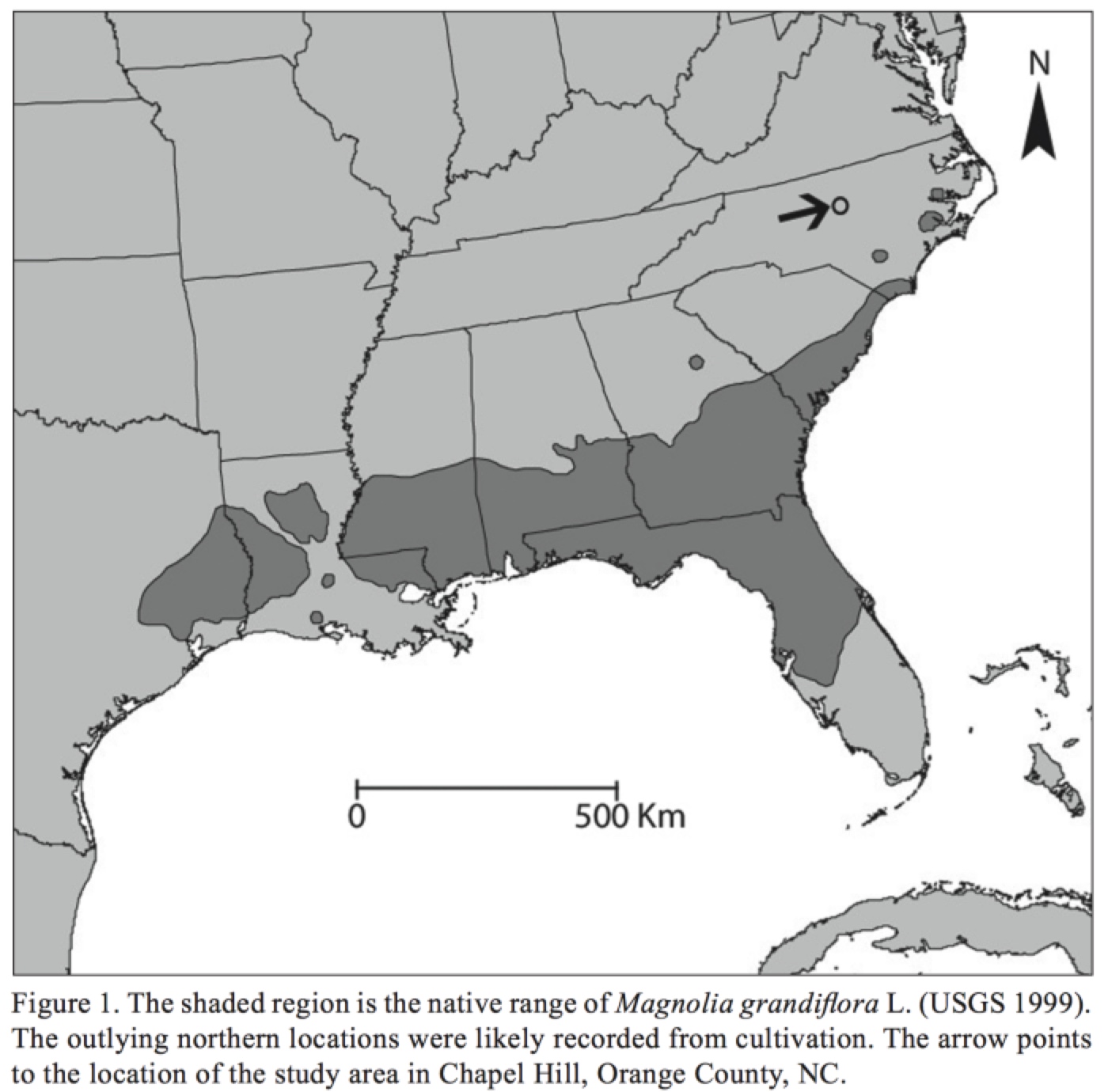 |
|
"Magnolia grandiflora L. Range Expansion:
A Case Study in a North Carolina Piedmont Forest, by Jennifer A. Gruhn and Peter S. White, 2011, Southeastern Naturalist, offers a useful analogy for how we see Florida Torreya becoming "naturalized" to North Carolina — evident in the grove of elder planted trees having naturally given rise to seedlings and saplings in its vicinity.
While unintentional, the natural dispersal and establishment of Southern Magnolia beyond its planting in the arboretum at Chapel Hill, is a fine example of poleward "assisted migration" of a southerly native species in this time of rapid climate change.
|
Return to HOME PAGE.